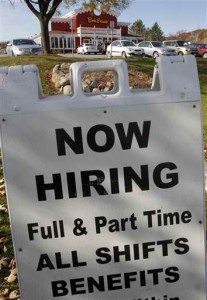
WASHINGTON — The latest evidence that the U.S. economy is making steady gains emerged Friday from a gauge of future economic activity, which rose in October at the fastest pace in eight months.
A string of better-than-expected economic reports this month has led some analysts to revise up their forecasts for growth. Still, they caution that their brighter outlook remains under threat from Europe’s financial crisis.
“Things are looking better than we thought they would — not great, but better,” said David Wyss, former chief economist at Standard & Poor’s.
The most recent sign was Friday’s report by the Conference Board that its index of leading economic indicators surged 0.9 percent last month. It was the index’s best showing since February. And it was far faster than the increases of 0.1 percent September and 0.3 percent in August.
The index is designed to predict economic activity. The October figure marked the sixth straight increase.
The jump reflected gains in nine of the index’s 10 components. Leading the way: a surge in permits for home construction; a narrower gap between short- and long-term interest rates that suggested less concern about inflation; a recovery in stock prices; and growth in the U.S. money supply.
A longer average workweek and fewer applications for unemployment benefits also contributed to the rise in the index.
All told, the components of the index signaled that the economy is steadily, if still slowly, strengthening.
On Thursday, the government reported further improvement in the number of people seeking unemployment benefits for the first time. The number fell to 388,000, the fewest since April.
In October, the economy added a net total of 80,000 jobs. It was the 13th straight month of gains. Still, the additional jobs were fewer than the roughly 125,000 that are needed each month just to keep up with population growth.
Many economists said the October gain in the leading indicators offered further assurance that the economy is in no imminent danger of slipping back into a recession, so long as Europe doesn’t fall into a severe downturn.
“This was a very positive reading for the leading indicators,” said Mark Zandi, chief economist at Moody’s Analytics. “The economy seems to be holding its own.”
Steven Wood, chief economist at Insight Economics, said the string of positive readings suggests “the economy should continue to experience at least moderate growth over the next six to nine months.”
In the first six months of the year, the economy grew at an annual rate of just 0.9 percent. Growth expanded to a 2.5 percent rate in the July-September quarter.
Before this month, many economists had estimated that growth in the current October-December quarter would roughly match the 2.5 percent pace of the July-September period. But in recent days, based on the healthier economic news, some analysts have boosted their forecasts.
This week, the government said retail sales in October and factory production were picking up. U.S. builders started slightly fewer homes in October. But building permits, a gauge of future construction, surged nearly 11 percent. That gain was led by a 30 percent increase in apartment permits, to their highest level in three years.
Wyss said he expected the annual growth rate in the current quarter to amount to about 3 percent, up from his earlier expectation of 2.5 percent. Economists at JPMorgan Chase & Co. are also expecting a 3 percent growth rate for the October-December period.
Wyss said one reason for his increased optimism is that he thinks a modest rebound in consumer spending will trigger companies to restock depleted shelves.
Even so, an economy growing at a 3 percent rate would still fall shy of the 4 percent to 5 percent pace that economists say is needed to significantly reduce the unemployment rate, which remains stuck at 9 percent.
And without stronger job gains, analysts say consumer spending, which accounts for about 70 percent of economic activity, will remain constrained.

